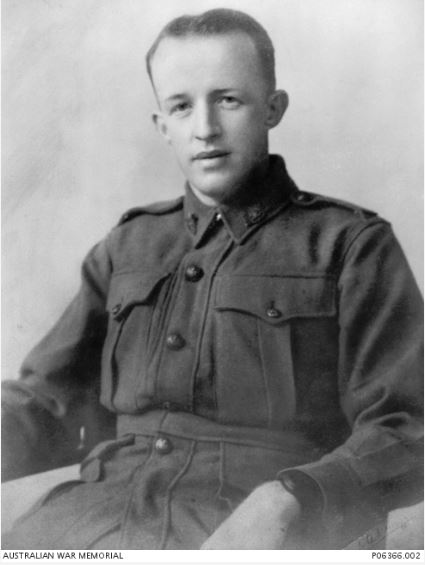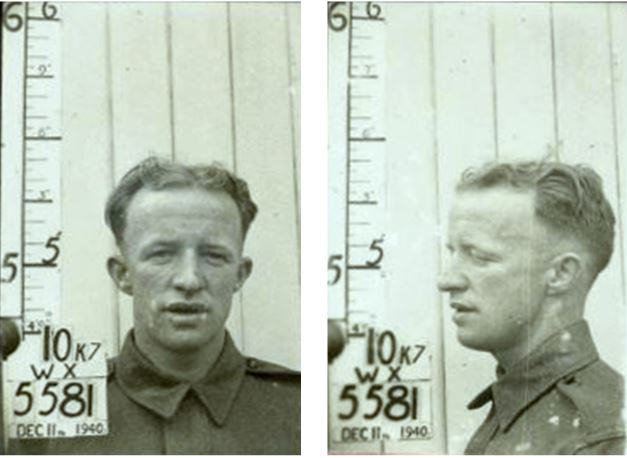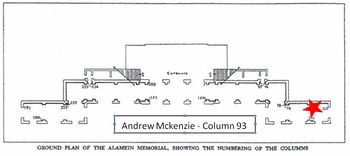Andrew McKenzie
From Our Contribution
 | |
 | |
| Personal Information | |
|---|---|
| Date of Birth | 15 Jul 1916 |
| Place of Birth | Katanning, Western Australia |
| Death | 17 Aug 1942 |
| Place of Death | MV Nino Bixio |
| Age at Enlistment | 24 years, 5 months |
| Occupation | Salesman |
| Religion | Church of England |
| Address | Karragullen, Western Australia |
| Next of Kin | , Mrs Margaret Fleay |
| Military Information | |
| Reg Number | WX5581 |
| Date of Enlistment | 11 Dec 1940 |
| Rank | Private |
| Unit/Formation | 2/28th Australian Infantry Battalion |
| Military Movement | |
| 1st Departure from Australia | |
| Journey Dates | 9 Jul 1941 ‒ 25 Jul 1941 |
| Transport Details | HMT Aquitania Fremantle to Port Tewfik via Colombo. |
| Post War Details | |
| Fate |
POW 26/27 Jul 1942 Ruin Ridge, Libya Died in captivity, at sea |
| Monument(s) |
Katanning Honour Board WA State War Memorial Alamein Memorial, El Alamein War Cemetery, Egypt |
| External Monument(s) | The Australian Ex-Prisoners of War Memorial Ballarat, Victoria |
| Australian War Memorial | Australian War Memorial |
| Medals |
1939-45 Star Africa Star Defence Medal War Medal 1939-45 Australian Service Medal 1939-45 |
Contents
[hide]Pre War
War Service
On 11 Dec 1940 Andrew enlisted in the 2nd AIF at Claremont and was sent to the training unit at Ascot on 13 Dec 1940. On 15 Jan 1941 Andrew was posted to the No 1 Training Battalion, and then on 12 Feb 1941 to the 13th Australian Infantry Training Battalion as part of the 6th Reinforcement draft for the 2/16th Battalion. He embarked with them on 5 Jul 1941 aboard HMT Aquitania, a part of Convoy US 11A which departed Fremantle on 9 July. Their route to the Middle East was via Colombo in Ceylon (Sri Lanka), and they disembarked at Port Tewfik on 25 Jul 1941.
Andrew was sent to the 21st Australian Infantry Training Battalion in Palestine until 5 Oct 1941 when he was posted to the 7th Australian Infantry Specialist Group, returning to the training battalion on 19 Nov 1941. On 22 May 1942 Andrew was posted to the 2/28th Australian Infantry Battalion. Several days later he changed his NOK to his Sister, Mrs Margaret Fleay. The next entry in Andrew's records was on 27 Jul 1942 noting that he was Missing in Action. What follows is a reconstruction from other sources.
On 25 May 1942 Rommel had begun his advance towards Egypt. Meanwhile, the 2/28th Battalion was exercising in northen Palestine during May and June, moving into Syria where the battalion played a role in a major exercise designed to show how Rommel could be stopped by massed artillery.
On 23 June 1942 the battalion returned to Tripoli, and late the next day received orders to preoceed with haste to Egypt with the rest of the 9th Australian Infantry Division. Some moved by rail, and some by road. Initially the 2/28th Battalion was held in reserve at Dikhelia near Alexandria before moving to Amiriyah on 5 July. On 8 July they returned to Dikhelia, but late on 10 Jul 1942 they moved forward to a position in the sandhills beside the sea, remaining there until 16 July when they finally moved forward into the front lines.
Early on 17 Jul 1942 the 2/28th Battalion along with the 2/32nd and the 2/43rd was sent to expand an existing salient in the German lines. Initial success by the other two battalions was soon met by a German counter attack. That evening the 2/28th were tasked with making a night attack along the Qattara Track, without artillery pre bombardment, to win back some of the day's lost territory. They were successful in taking their objective, but paid for it next day with relentless German shelling. Over the next few days the battalion sent out fighting patrols to establish enemy dispositions. The next attack by the 24th Brigade was towards Miteriya Ridge south of their current position, the ridge was to become known as Ruin Ridge. The position was taken, by tanks and vehicle born troops but soon after given up when it was thought that they had advanced one ridge too far. In the meantime the infantry was advancing in the setting sun towards German positions and they came under heavy fire. Their final position was two ridges short of their objective.
In the evening of 26 Jul 1942 the battalion took part in the second attack on Ruin Ridge which the Germans now held in strength. Unlike the previous two attacks, this one was to occur at night, under a bright moon. The right flank of the 2/28th battalion was acknowleged to be vulnerable but was not to be supported until they had successlfully reached the ridge. This they did, with Rommel in his diary, noting they had 'wiped out the greater part of one German Battalion'. However, attempts to bring forward supplies, etc led to 13 trucks being destroyed along with their contennts in the minefields and from artillery strikes before they could reach the troops with ammunition and stores. At first light on the 27th the 2/28th Battalion was on borrowed time, and several attempts too resupply them with ammuniion failed. By 10:03 am they were surrounded by German tanks, and without support were forced to surrender. It is highly likely that this is when Andrew was captured.
Initially the POWs were handed over to the Italians to manage. Captured in boots, shorts, and short sleeved shirt Andrew would have only been given a groundsheet. He was taken to Benghazi, in overcrowded trucks, a journey taking between 2 and 4 days, and then held in the 'Palms' camp, one of two transit camps, before being transported to Italy. On 16 Aug 1942 the POWs in the 'Palms' Camp were loaded onto trucks and taken to the harbour where a half of them, Andrew included, boarded the SS Nino Bixio. She sailed that night and in the afternoon of the following day the ship was hit by two torpedoes from a British submarine HMS Turbulent. The first exploded in the ship's forward, No 1 hold jam packed with 504 POW's, killing half of them, including 25 from the 2/28th Battalion. It is reasonable to conclude that this is when Andrew lost his life.
Reported "Missing" in the West Australian 29 Aug 1942, and later in the same newspaper's 24 Oct 1942 edition "POW".
Notes
- For further details in relation to the fatal voyage across the Mediterraen Sea, visit https://nzhistory.govt.nz/page/attack-nino-bixio (accessed 23 Mar 2019).
- Andrew's army records contain very little detail, so much of the story above is deduced from The Second 28th - The Story of the 2/28th Australian Infantry Battalion in World Was II by Philip Masel, published by the 2/28th Battalion and 24th Anit-Tank Company Association, Inc

